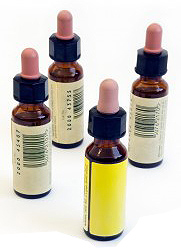What are Flower Essences?

Because the term Flower Essence is similar to the term Essential Oil, people sometimes get the terms confused. For this reason, I'll briefly introduce and describe Flower Essences within this article.

Bach Flower Essences, also known as Flower Remedies, are a liquid homeopathic treatment that is most commonly taken internally. Flower Essences are not aromatic and are not used within the scope of holistic aromatherapy.
Flower essences are not the same as essential oils and are not used directly within the scope of holistic aromatherapy.
Though Bach Flower Essences aren't used directly within the field of holistic aromatherapy, it is not uncommon for individuals to utilize both essentials oils and flower essences as a part of their holistic lifestyle.
In the early part of the 20th century, an English homeopath named Edward Bach began to explore the concept that that the natural energy and signature vibrations found in particular botanicals could be captured and utilized to help improve particular emotional states. He found 38 particular botanicals to be the most beneficial. Each flower essence is intended to help remedy a particular negative emotional state.
A flower essence is created by adding the petals of a particular botanical to spring water. The mixture is then either allowed to bask in the sun for several hours or is boiled. The choice of method is dependent on the particular botanical and the preparer. The resulting essence is further diluted down with additional spring water. Alcohol, usually brandy, is then added to preserve the essence and to further dilute it.
Bach Flower Essences are considered a homeopathic treatment, but a couple differences exist. Typical homeopathic remedies are generally created by taking a "toxic" substance and diluting it down significantly until only the most minuscule trace of the original substance remains. The concept is that "let like cure like."
Bach Flower Essences, on the other hand, are created by using non-toxic flowers with the belief amongst practitioners that the soul of the plant and its healing vibrations are imparted into the final essence.
Another difference between traditional homeopathic remedies and Bach Flower Essences is that with homeopathic remedies, some substances (i.e. mint products) are considered antidotes to the homeopathic remedy and cannot be taken simultaneously with the remedy.
Although I'm not aware of any scientific studies that verify the effectiveness of Bach Flower Essences, countless people swear by their effectiveness.
Traditional Bach Flower Remedies
The list below displays the 38 flowers that comprise the traditional Bach Flower Remedies. I've included a very brief description of the negative state that the essence is intended to remedy. As these descriptions are especially short, do keep in mind that further research and reading should be conducted before concluding that a particular remedy is suitable for a particular need.
- Agrimony: Camouflaging hidden turmoil.
- Aspen: Fear of the unknown or supernatural.
- Beech: Judgmental and hateful/jealous.
- Centaury: Saying no when necessary proves difficult.
- Cerato: Mistrust of oneself.
- Cherry Plum: Fear of going crazy or making a hasty decision.
- Chestnut Bud: Inability to learn from errors and mistakes.
- Chicory: Pushy and selfish.
- Clematis: Excessive daydreaming or focus on the future.
- Crab Apple: Feeling unclean, sinful or unworthy.
- Elm: Obligations are overwhelming.
- Gentian: Discouraged.
- Gorse: Hopeless.
- Heather: Alienates others yet is afraid of being alone.
- Holly: Jealous, envious or spiteful.
- Honeysuckle: Focusing on the positives or negatives of the past.
- Hornbeam: Unable to find the drive to tackle projects.
- Impatiens: Impatient.
- Larch: Needing self confidence.
- Mimulus: Fear of common events or things.
- Mustard: Unknown depression.
- Oak: Continually pushing oneself too hard.
- Olive: Burned out.
- Pine: Constant feelings of guilt.
- Red Chestnut: Excessive worry over others.
- Rock Rose: Intense fright and panic.
- Rock Water: Rigidly refraining from life's pleasures.
- Scleranthus: Indecisive.
- Star of Bethlehem: Traumatized.
- Sweet Chestnut: Anguish over hopeless situation.
- Vervain: Overenthusiastic, stubborn yet pushy.
- Vine: Domineering.
- Walnut: Experiencing life transition.
- Water Violet: Arrogant.
- White Chestnut: Inability to focus due to reoccurring thoughts.
- Wild Oat: Unable to set or stick with goals.
- Wild Rose: Apathy.
- Willow: Bitterness, resentment and self-pity.
Rescue Remedy
In addition to the 38 single Bach Flower Essences, a combination remedy known as Rescue Remedy is commonly available. It is intended for short term use in periods of serious emotional duress, stress or trauma. It consists of the following five flower essences. See the above list for a description for each of the individual essences contained within the Rescue Remedy.
- Cherry Plum
- Clematis
- Impatiens
- Rock Rose
- Star of Bethlehem
AromaWeb's Aromatherapy Business Directory provides a categorical directory of sellers of Flower Essences.
Do Not Use Flower Essences As a Substitute for Proper Medical Care
The intention of this article is to help explain what flower essences are and how they are commonly used. It is intended for basic, general informational purposes only. Flower essences should not be used in place of seeing your doctor or seeking appropriate medical care when necessary.
Flower Essence Books

The Bach Flower Remedies
Author: Edward Bach and E.J. Wheeler
Publisher: McGraw-Hill
Copyright: 1998
ISBN: 0879838698 / 978-0879838690
Pages: 248

The Encyclopedia of Bach Flower Therapy
Author: Mechthild Scheffer
Publisher: Healing Arts Press
Copyright: 2001
ISBN: 0892819413 / 978-0892819416
Pages: 400
